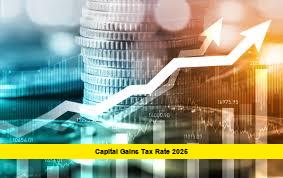The capital gains tax rate 2025 is a hot topic for investors, homeowners, and anyone planning a major asset sale this year. The IRS recently published updated thresholds for both long-term and short-term capital gains taxes, with new income limits that affect millions of taxpayers.
Major highlights include unchanged core tax rates, but adjusted income brackets designed to keep up with inflation and income growth across the U.S.
Table of Contents
What Is the Capital Gains Tax Rate 2025?
For 2025, capital gains tax rates remain at three familiar levels: 0%, 15%, and 20% for long-term gains. The easiest way to determine your capital gains tax bracket is by reviewing your filing status and taxable income.
Here are the long-term capital gains tax rates for assets held over one year:
| Tax Rate | Single | Married Filing Jointly | Married Filing Separately | Head of Household |
|---|---|---|---|---|
| 0% | 0to0to48,350 | 0to0to96,700 | 0to0to48,350 | 0to0to64,750 |
| 15% | 48,351to48,351to533,400 | 96,701to96,701to600,050 | 48,351to48,351to300,000 | 64,751to64,751to566,700 |
| 20% | $533,401 or more | $600,051 or more | $300,001 or more | $566,701 or more |
Short-term capital gains, which apply to assets held for one year or less, are taxed according to ordinary income brackets. That means your gains will be taxed at rates ranging from 10% up to 37%, depending on your taxable income.
What Changed in 2025? New Thresholds and Brackets
While the capital gains tax rate 2025 itself did not change, the IRS increased the income thresholds for each rate. This adjustment helps taxpayers—especially in lower and middle income ranges—potentially benefit from favorable rates even if their earnings rise.
Key updates:
- Minimum income thresholds went up, reflecting inflation.
- Extended the top 20% rate to higher income limits than last year.
- The 0% bracket now covers more Americans, with many filers eligible if their income is below 48,350(single)or48,350(single)or96,700 (joint).
These changes offer savings for households whose earnings have grown but are still below the new bracket levels.
How to Determine Your Capital Gains Tax Rate for 2025
Here’s a quick guide:
- Are you selling an asset held more than 12 months? You get the preferential long-term rate.
- Single filers earning less than $48,350: Your gains may be taxed at 0%.
- Joint filers earning under $96,700: Also in the 0% bracket.
- Income above these limits: Most will pay 15%. Very high earners face 20% (plus an additional 3.8% Net Investment Income Tax above certain thresholds).
- Assets held for 12 months or less: Taxed at your standard income rate.
Table: Quick Reference for 2025 Capital Gains Tax Rates
| Filing Status | 0% Rate | 15% Rate | 20% Rate |
|---|---|---|---|
| Single | 0–0–48,350 | 48,351–48,351–533,400 | $533,401+ |
| Married Filing Jointly | 0–0–96,700 | 96,701–96,701–600,050 | $600,051+ |
| Married Filing Separately | 0–0–48,350 | 48,351–48,351–300,000 | $300,001+ |
| Head of Household | 0–0–64,750 | 64,751–64,751–566,700 | $566,701+ |
Frequently Asked: What About the Net Investment Income Tax?
Many high-earners should keep the Net Investment Income Tax in mind. This adds 3.8% to the capital gains rate for singles above 200,000andjointfilersabove200,000andjointfilersabove250,000, making the effective maximum tax on long-term gains up to 23.8%.
Expert Tips for Tax Planning in 2025
- Time your sales for maximum tax advantage. If possible, hold investments longer than one year to secure lower rates.
- Track your adjusted gross income and deductions; a small drop in income may shift you fully into the 0% or 15% bracket.
- Use tax-loss harvesting to offset gains, especially for short-term profits taxed at higher ordinary rates.
Will the Capital Gains Tax Rate Change Again Soon?
There are no new legislative proposals in 2025 to change current capital gains rates. All published IRS material confirms that the 0%, 15%, and 20% brackets are in force this year.
If Congress acts on future tax reform, updates will be reflected immediately. At present, these rates and brackets are the most up-to-date figures for taxpayer planning.
Final Thoughts
The capital gains tax rate 2025 gives most investors predictable rates and added flexibility, as income brackets have adjusted for inflation. Anticipate savings if your earnings increased modestly last year. For personalized advice, consult a tax specialist—and share your questions or experiences in the comments below to help others stay informed.
